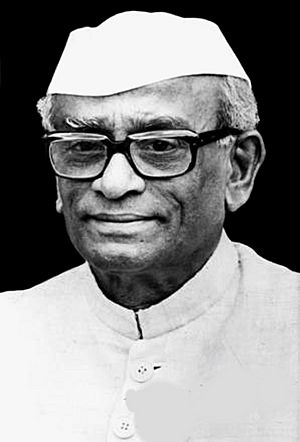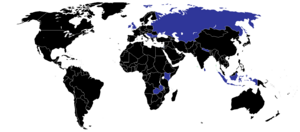Neelam Sanjiva Reddy facts for kids
Quick facts for kids
Neelam Sanjiva Reddy
|
|
|---|---|

Neelam in January 1977
|
|
| 6th President of India | |
| In office 25 July 1977 – 25 July 1982 |
|
| Prime Minister | |
| Vice President | |
| Preceded by | Fakhruddin Ali Ahmed |
| Succeeded by | Zail Singh |
| 4th Speaker of the Lok Sabha | |
| In office 17 March 1967 – 19 July 1969 |
|
| Deputy | R.K. Khadilkar |
| Preceded by | Hukam Singh |
| Succeeded by | Gurdial Singh Dhillon |
| In office 26 March 1977 – 13 July 1977 |
|
| Deputy | Godey Murahari |
| Preceded by | Bali Ram Bhagat |
| Succeeded by | K. S. Hegde |
| Minister of Steel and Mines | |
| In office 9 June 1964 – 11 January 1966 |
|
| Prime Minister | Lal Bahadur Shastri |
| 1st Chief Minister of United Andhra Pradesh | |
| In office 12 March 1962 – 20 February 1964 |
|
| Governor |
|
| Preceded by | Damodaram Sanjivayya |
| Succeeded by | Kasu Brahmananda Reddy |
| In office 1 November 1956 – 11 January 1960 |
|
| Governor |
|
| Preceded by | Office Established |
| Succeeded by | Damodaram Sanjivayya |
| President of Indian National Congress | |
| In office 1960–1963 |
|
| Preceded by | Indira Gandhi |
| Succeeded by | K. Kamaraj |
| Personal details | |
| Born | 19 May 1913 Illur, Madras Presidency, British India (present-day Andhra Pradesh, India) |
| Died | 1 June 1996 (aged 83) Bangalore, Karnataka, India (present-day Bengaluru) |
| Political party | Janata Party (from 1977) |
| Other political affiliations |
Indian National Congress (before 1977) |
| Spouse | Neelam Nagaratnamma |
| Alma mater | University of Madras |
Neelam Sanjiva Reddy was an important Indian politician. He was the sixth President of India from 1977 to 1982. He started his long political journey with the Indian National Congress party. This was during the time when India was fighting for its freedom.
After India became independent, he held many important jobs. He was the Deputy Chief Minister of Andhra State. He also became the first Chief Minister of Andhra Pradesh. He served two times as the Speaker of the Lok Sabha (which is like the head of India's main parliament house). He was also a Union Minister before becoming the President.
Reddy was born in a village that is now in Andhra Pradesh. He went to college but left to join the Indian independence movement. He was even put in jail for taking part in the Quit India Movement. He was elected to the Madras Legislative Assembly in 1946. Later, he became the Deputy Chief Minister of Andhra State in 1953. In 1956, he became the first Chief Minister of Andhra Pradesh. He also worked as a Union Minister under Prime Ministers Lal Bahadur Shastri and Indira Gandhi. He was the Lok Sabha Speaker from 1967 to 1969. He took a break from politics but returned in 1975.
In 1977, he was elected to Parliament as a candidate for the Janata Party. He was chosen as the Speaker of the Sixth Lok Sabha without anyone opposing him. Just three months later, he was elected President of India, again without anyone opposing him. As President, he worked with Prime Ministers Morarji Desai, Charan Singh, and Indira Gandhi. After his term ended in 1982, he retired to his farm. He passed away in 1996.
Contents
Early Life and Education
Neelam Sanjiva Reddy was born on 19 May 1913. His family spoke Telugu and lived in Illur village. This village was part of the Madras Presidency back then. Today, it is in the Anantapur district of Andhra Pradesh.
He went to the Theosophical High School in Adyar, Chennai. Later, he joined the Government Arts College at Anantapur. This college was linked to the University of Madras. In 1958, Sri Venkateswara University gave him an honorary law degree. They did this because he helped a lot in setting up the university.
Reddy was married to Neelam Nagaratnamma. They had one son and three daughters.
Role in India's Freedom Fight
Reddy joined India's fight for independence from British rule. He was inspired by Mahatma Gandhi's visit to Anantapur in 1929. He left college in 1931 to focus on the freedom movement.
He was very involved with the Youth League. He also took part in student protests called satyagraha. In 1938, he became the Secretary of the Andhra Pradesh Congress Committee. He held this position for ten years.
During the Quit India Movement, he was arrested and spent a lot of time in jail. He was in jail mostly between 1940 and 1945.
Political Journey
In 1946, Reddy was elected to the Madras Legislative Assembly. He represented the Congress party. He also became a member of the Indian Constituent Assembly. This group helped write India's Constitution. From 1949 to 1951, he was a Minister in the Madras State. He looked after areas like housing and forests.
Deputy Chief Minister of Andhra State
In 1951, Reddy was elected President of the Andhra Pradesh Congress Committee. When the Andhra State was formed in 1953, he became its Deputy Chief Minister.
Chief Minister of Andhra Pradesh
After the state of Andhra Pradesh was formed in 1956, Reddy became its first Chief Minister. He served from 1 November 1956 to 11 January 1960. He held this important job for over five years.
He became Chief Minister for a second time from 12 March 1962 to 20 February 1964. During his time as Chief Minister, big projects like the Nagarjuna Sagar Dam and Srisailam Dam were started. These dams help with water and electricity. The Government of Andhra Pradesh later renamed the Srisailam project in his honor.
Reddy's governments focused on improving villages and farming. In 1960, he resigned as Chief Minister because he was elected President of the Indian National Congress.
Congress President and Union Minister
Reddy served as the President of the Indian National Congress three times. This was from 1960 to 1962. In 1962, he gave a strong speech about India's determination. He spoke about ending the Chinese occupation of Indian land. He also talked about the freedom of Goa.
From June 1964, Reddy was a Union Minister in Lal Bahadur Shastri's government. He was in charge of Steel and Mines. Later, from 1966 to 1967, he was a Union Minister in Indira Gandhi's government. He handled Transport, Civil Aviation, Shipping, and Tourism.
Speaker of the Lok Sabha
In the 1967 elections, Reddy was elected to the Lok Sabha. On 17 March 1967, he was chosen as the Speaker of the Fourth Lok Sabha. This is a very important role, like being the referee of the Parliament. To show that the Speaker's job is fair and independent, Reddy resigned from the Congress Party.
His time as Speaker was special. He allowed a "No-Confidence Motion" (a vote to show if the government still has support) on the same day the President spoke to Parliament. He also set up a committee to help Scheduled Castes and Scheduled Tribes. Reddy said his job was to be the "watchman of the Parliament."
Presidential Election of 1969
In 1969, after President Zakir Hussain passed away, the Congress party chose Reddy as their candidate for President. However, Prime Minister Indira Gandhi did not support him. She asked Congress members to "vote according to their conscience." This meant she wanted them to support the other candidate, V. V. Giri.
In a very close election on 16 August 1969, V. V. Giri won. Reddy then resigned as Speaker and decided to take a break from politics. He moved back to his farm in Anantapur.
Return to Politics
Reddy returned to politics in 1975. He joined the Janata Party. In March 1977, he ran in the general election from Andhra Pradesh. He was the only non-Congress candidate to win from that state. The Congress Party, led by Indira Gandhi, lost the election. A new group of parties, the Janata Party, came to power with Morarji Desai as Prime Minister.
Reddy was again chosen as the Speaker of the Sixth Lok Sabha on 26 March 1977. Everyone agreed on his selection. But he resigned just a few months later to run for President in July 1977. His second time as Speaker was the shortest ever.
Presidential Election of 1977
The 1977 presidential election happened because the President, Fakhruddin Ali Ahmed, passed away. Reddy was elected President without anyone opposing him. This was a unique event. All political parties, even the opposition Congress party, supported him.
At 64 years old, he was the youngest person to become President of India until 2022. He was also the only serious candidate to run for President twice. Many candidates filed their nominations, but most were rejected. Reddy was the only valid candidate left, so no election was needed. He became the first and only President of India to be elected without a contest.
President of India

Neelam Sanjiva Reddy was sworn in as the sixth President of India on 25 July 1977. As President, he worked with three different Prime Ministers: Morarji Desai, Charan Singh, and Indira Gandhi.
On the eve of India's 30th Independence Day, Reddy made an important announcement. He said he would move out of the big Rashtrapati Bhavan (the President's official home) into a smaller place. He also said he would take a 70 percent pay cut. He did this to show support for India's poor people.
Working with Prime Ministers
Reddy's relationship with Prime Minister Morarji Desai became difficult. Desai's government ended in July 1979. Reddy then appointed Charan Singh as the next Prime Minister. Singh was asked to prove he had enough support in Parliament. However, he never faced Parliament because the Congress Party, led by Indira Gandhi, withdrew its support.
After Charan Singh resigned, Reddy decided to dissolve the Lok Sabha. He called for new elections. Singh was asked to continue as a caretaker Prime Minister until a new government was formed. Reddy's decision was criticized by some.
In the 1980 elections, Indira Gandhi's party won a large number of seats. Reddy swore her in as Prime Minister in January 1980. Between 1980 and 1982, President Reddy made seven official visits to other countries. He visited places like the Soviet Union, the UK, and Indonesia.
Later Life and Legacy
Zail Singh became the next President after Reddy on 25 July 1982. In his farewell speech, Reddy spoke about how governments had not done enough to improve the lives of ordinary Indians. He called for a strong political opposition to keep the government in check.
After his time as President, Reddy chose to retire to his farm in Anantapur. He passed away from pneumonia in Bangalore in 1996 at the age of 83. His resting place is at Kalpally Burial Ground in Bangalore.
Reddy wrote a book called Without Fear or Favour: Reminiscences and Reflections of a President. It was published in 1989.
Remembering Neelam Sanjiva Reddy
In 2013, the Government of Andhra Pradesh celebrated 100 years since Reddy's birth. The then President of India, Pranab Mukherjee, attended the main ceremony.
The Postal Department of India released a special stamp and cover to honor him. There is also a college named after him in Hyderabad. The Government of Andhra Pradesh has announced that some other institutions will also be renamed after him. These include his old college, the Government Arts College.

